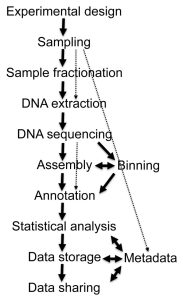در مقاله ای که اخیرا توسط گروهی از دانشمندان اروپایی چاپ شده است به نقش مخرب کربوهیدرات ها برای سلامتی بدن اشاره شده است.
کربوهیدرات ها قسمت اعظم رژیم غذایی ما را به خود اختصاص میدهند. لیکن ثابت شده است که مصرف غلات تصفیه شده (مثل آرد سفید)، قندهای ساده (مثل شکر)، و کربوهیدرات های با کیفیت پایین نقش مخربی برای سیستم عصبی، قلبی عروقی، گوارشی و … بازی میکنند و به عنوان عامل بیماریهای مزمن در جهان قرن ۲۱ معرفی شده اند. دانشمندان عقیده دارند که بخش عمده ای از سرعت فزاینده بروز بیماریها (مثل چاقی، دیابت، سندرم متابولیک و بیماریهای عصبی) در قرن اخیر به مصرف غذاهای مضر برمیگردد. امروزه تغییر عادات غذایی مردم بخصوص در جهان غرب از غذاهای گیاهی به غذاهای گوشتی و قندهای ساده از دلایل افزایش بیماری ها به حساب می آید. گفته میشود غذای مردم امروزی نسبت به قبل کم حجم و پر کالری شده است. بشر امروزی قد و وزن بیشتر، حجم مغز بزرگتر و دندانهای ضعیف تری نسبت به انسان اولیه دارد که بواسطه تغییر الگوی غذایی اوست. تحقیقات نشان می دهد بواسطه مصرف بیشتر کربوهیدرات ها، ترشح آمیلاز (آنزیم هضم کننده نشاسته) نسبت به قبل بیشتر شده که این امر سطح قند خون را بالا می برد. از تغییرات دیگری که حادث شده تغییر در طریقه پخت و پز است که مطابق با کاهش مصرف غذاهای فیبری و ضعف جویدن می باشد. حتی گفته میشود این الگوی مصرف منجر به کاهش طول روده کوچک در انسان امروزی شده است.
نقش کربوهیدراتها در سلامت روده
در بدن انسان انواع میکروبها شامل باکتریها، قارچها، ویروسها، آرکی ها و انگلها وجود دارند که در شرایطی که تعادل آنها حفظ شود بدن را در حالت سلامتی نگه می دارند. این میکروارگانیسمها از دهان تا ریه و دستگاه گوارش وجود دارند ولی قسمت اعظم آنها در روده هستند. باکتریهای روده وظایف مهمی همچون تولید انرژی، استحکام بافت اپیتلیال روده، مبارزه با میکروبهای بیماریزا و تامین ایمنی را به عهده دارند. باکتریهای روده در تخمیر بی هوازی کربوهیدراتهای هضم نشده مثل فیبرهای غذایی و تبدیل آنها به اسیدهای چرب کوتاه زنجیره نقش دارند. اسیدهای چرب کوتاه زنجیره در کاهش اشتها و جلوگیری از چاقی موثر هستند.
بخشی از کربوهیدراتها فیبرها هستند. فیبرهای غذایی به چند طریقه قابل تقسیم بندی هستند. فیبرهایی که از بیش از ۱۰ منومر تشکیل شده باشند کربوهیدراتهای غیر قابل هضم نامیده میشوند که شامل سلولز، همی سلولز، اینولین، پکتین، صمغ، پسیلیوم ، موسیلاژ و بتاگلوکانها هستند. در مقابل، فیبرهای تشکیل شده از ۳ تا ۹ منومر الیگوساکاریدهای مقاوم نامیده میشوند و شامل گالاکتوالیگوساکاریدها و فروکتوالیگوساکاریدها هستند.
اما نقش فیبرها به قابلیت تولید صمغ، محلول بودن در آب و تخمیر پذیری توسط باکتریهای روده برمی گردد. فیبرهای غذایی نقش مهمی در تنوع و تعادل جمعیت میکروبی روده (میکروبیوتا) دارند.
تحقیقات نشان میدهند مصرف فیبرهای غذایی با تاثیری که بر تعدیل جمعیت میکروبی روده دارند در سلامت جسم و روح موثر هستند. جمعیت میکروبی روده در جوامع غربی که مصرف فیبرها کم است و مصرف گوشت و چربیها زیاد است نسبت به جوامعی که فیبر بیشتر مصرف میکنند متفاوت است. تحقیقات حاکی از این است که جمعیت پرووتلاها در جوامع شرقی و افریقایی نسبت به جوامع غربی بیشتر است که بواسطه مصرف بیشتر فیبرها می باشد. کربوهیدراتهای کوتاه شامل منو و دی ساکاریدها که عمدتا در فست فودها یافت میشوند توسط میکروبهای دستگاه گوارش قابل تخمیر نیستند و چنانچه به میزان زیاد مصرف شوند تعادل میکروبی روده را برهم میزنند. پس بطور خلاصه باید گفت که کربوهیدراتها با واسطه جمعیت میکروبی روده بر سلامتی یا بیماری بدن بسیار تاثیرگذار هستند.
نتیجه گیری:
- افزایش بروز چاقی و بیماری های متابولیک در جهان امروز، مرتبط با تغییرات در رفتارهای غذایی است.
- طبق دستورالعمل های تغذیه ای، کربوهیدرات ها ۴۰٪ تا ۶۵٪ از کل روزانه را تشکیل می دهند. لیکن مصرف روزانه توصیه شده کربوهیدرات ها باید بر اساس غلات کامل باشد.
- بیش از مقدار، ماهیت و نوع کربوهیدرات ها در سلامتی یا بیماری مهم است.
- افزایش مصرف غلات و قندهای تصفیه شده و همچنین روغنهای گیاهی تصفیهشده و گوشتهای چرب، ریشه افزایش بیماری های مزمن مرتبط با تغذیه هستند.
- مصرف قندهای ساده در اغذیه و نوشیدنی های قندی با بیماری آسم، بیماریهای متابولیک، و مشکلات خلقی مرتبط است.
- تنوع و تعادل در جمعیت میکروبی روده مترادف با سلامتی است و در این میان، فیبرهای غذایی به عنوان غذای باکتریهای روده، دارای اهمیت زیادی است.
- کربوهیدرات های پیچیده و فیبرهای غذایی میتوانند بر کاهش التهاب، جلوگیری از تکثیر سلولی و رشد تومور موثر واقع شوند..
- کربوهیدرات های پیچیده و فیبر می توانند دفع مواد سرطان زا از مدفوع را افزایش دهند.
- مصرف منابع غذایی با شاخص گلیسمی پایین و فیبر باید بیشتر از ۲۵ تا ۳۰ گرم در روز باشد.
تهیه شده توسط دکتر نازیلا کسائیان
References:
Kopp, W. How Western Diet and Lifestyle Drive the Pandemic Of Obesity and Civilization Diseases. Diabetes Metab. Syndr.Obes. ۲۰۱۹, ۱۲, ۲۲۲۱–۲۲۳۶. https://doi.org/10.2147/DMSO.S216791.
O’Grady, J.; O’Connor, E.M.; Shanahan, F. Review Article: Dietary Fiber in the Era of Microbiome Science. Aliment. Pharmacol.Ther. 2019, 49, 506–۵۱۵.
https://doi.org/10.1111/apt.15129.
Cronin, P.; Joyce, S.A.; O’Toole, P.W.; O’Connor, E.M. Dietary Fiber Modulates the Gut Microbiota. Nutrients ۲۰۲۱, ۱۳, ۱۶۵۵.
https://doi.org/10.3390/nu13051655.
Chanmuang, S.; Nguyen, Q.-A.; Kim, H.-J. Current Research on the Effects of Non-Digestible Carbohydrates on Metabolic Disease. Appl. Sci. 2022, 12, 3768. https://doi.org/10.3390/app12083768.





